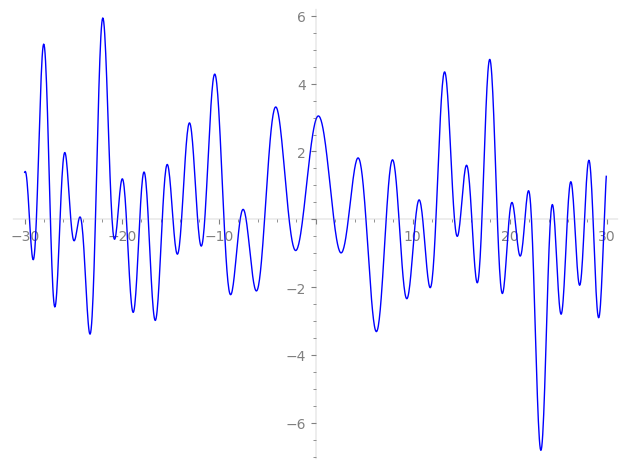| L(s) = 1 | + 4.28i·2-s + (49.1 − 64.3i)3-s + 237.·4-s − 147. i·5-s + (275. + 210. i)6-s + 2.56e3·7-s + 2.11e3i·8-s + (−1.72e3 − 6.33e3i)9-s + 632.·10-s + 4.41e3i·11-s + (1.16e4 − 1.52e4i)12-s − 2.74e4·13-s + 1.09e4i·14-s + (−9.50e3 − 7.26e3i)15-s + 5.17e4·16-s − 1.21e5i·17-s + ⋯ |
| L(s) = 1 | + 0.267i·2-s + (0.607 − 0.794i)3-s + 0.928·4-s − 0.236i·5-s + (0.212 + 0.162i)6-s + 1.06·7-s + 0.516i·8-s + (−0.262 − 0.964i)9-s + 0.0632·10-s + 0.301i·11-s + (0.563 − 0.737i)12-s − 0.962·13-s + 0.285i·14-s + (−0.187 − 0.143i)15-s + 0.790·16-s − 1.44i·17-s + ⋯ |
\[\begin{aligned}\Lambda(s)=\mathstrut & 33 ^{s/2} \, \Gamma_{\C}(s) \, L(s)\cr =\mathstrut & (0.794 + 0.607i)\, \overline{\Lambda}(9-s) \end{aligned}\]
\[\begin{aligned}\Lambda(s)=\mathstrut & 33 ^{s/2} \, \Gamma_{\C}(s+4) \, L(s)\cr =\mathstrut & (0.794 + 0.607i)\, \overline{\Lambda}(1-s) \end{aligned}\]
Particular Values
| \(L(\frac{9}{2})\) |
\(\approx\) |
\(2.76736 - 0.936409i\) |
| \(L(\frac12)\) |
\(\approx\) |
\(2.76736 - 0.936409i\) |
| \(L(5)\) |
|
not available |
| \(L(1)\) |
|
not available |
\(L(s) = \displaystyle \prod_{p} F_p(p^{-s})^{-1} \)
| $p$ | $F_p(T)$ |
|---|
| bad | 3 | \( 1 + (-49.1 + 64.3i)T \) |
| 11 | \( 1 - 4.41e3iT \) |
| good | 2 | \( 1 - 4.28iT - 256T^{2} \) |
| 5 | \( 1 + 147. iT - 3.90e5T^{2} \) |
| 7 | \( 1 - 2.56e3T + 5.76e6T^{2} \) |
| 13 | \( 1 + 2.74e4T + 8.15e8T^{2} \) |
| 17 | \( 1 + 1.21e5iT - 6.97e9T^{2} \) |
| 19 | \( 1 - 1.95e5T + 1.69e10T^{2} \) |
| 23 | \( 1 - 3.19e5iT - 7.83e10T^{2} \) |
| 29 | \( 1 + 9.64e5iT - 5.00e11T^{2} \) |
| 31 | \( 1 + 7.51e5T + 8.52e11T^{2} \) |
| 37 | \( 1 + 3.03e6T + 3.51e12T^{2} \) |
| 41 | \( 1 - 2.07e6iT - 7.98e12T^{2} \) |
| 43 | \( 1 - 1.45e6T + 1.16e13T^{2} \) |
| 47 | \( 1 - 8.01e6iT - 2.38e13T^{2} \) |
| 53 | \( 1 + 1.56e6iT - 6.22e13T^{2} \) |
| 59 | \( 1 - 1.83e7iT - 1.46e14T^{2} \) |
| 61 | \( 1 + 4.66e6T + 1.91e14T^{2} \) |
| 67 | \( 1 - 2.39e6T + 4.06e14T^{2} \) |
| 71 | \( 1 - 1.85e5iT - 6.45e14T^{2} \) |
| 73 | \( 1 - 1.29e7T + 8.06e14T^{2} \) |
| 79 | \( 1 + 3.28e7T + 1.51e15T^{2} \) |
| 83 | \( 1 - 6.20e7iT - 2.25e15T^{2} \) |
| 89 | \( 1 - 4.32e7iT - 3.93e15T^{2} \) |
| 97 | \( 1 - 3.04e7T + 7.83e15T^{2} \) |
| show more | |
| show less | |
\(L(s) = \displaystyle\prod_p \ \prod_{j=1}^{2} (1 - \alpha_{j,p}\, p^{-s})^{-1}\)
Imaginary part of the first few zeros on the critical line
−14.71245670390888863748861337575, −13.82982554872500009770307323339, −12.17189782608311533748806438997, −11.43845033278914467679325476013, −9.456068545994511385719423317371, −7.78827988196722415637198224690, −7.17385191332518555515469041419, −5.27352634038577647330459990342, −2.74032677547833710885966420799, −1.34685062512187714496693299678,
1.87038534389991645317107061722, 3.35772121840250522884115406374, 5.17815210526648330607668193236, 7.26022371473617366747296191611, 8.584162309834319990379037822847, 10.28696911752472690341475911938, 11.02956932248398463259121448898, 12.38836689134639191844915704484, 14.30578239152036287749329468939, 14.89770902878138525814964082965

